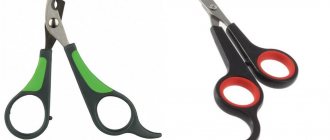Almost every family has a beloved pet. Some people breed cats, others dogs, others love more exotic animals - snakes, unusual fish, lizards. Well, small animals like hamsters are one of the most common types of pets. They don’t take up much space, they live in their own cage, they need little food, and you can spend hours watching the hamsters spinning amusingly in the wheel.
To find out, zoologists spent quite a long time tracking the behavior of hamsters in their natural habitat.
It was found that an adult hamster can run about 12 kilometers !
Why does a hamster need a wheel?
It's all about instincts. Hamsters run around a lot in the wild in search of food. You could say, “ the hamster’s feet feed him .”
Although hamsters do not eat much, these animals are accustomed to hiding food in reserve. That's why they need constant replenishment of supplies. And in an artificial living environment, they do not need to find food for themselves, but the instinct remains. Therefore, a wheel in their cage is simply necessary. The second reason why hamsters run on a wheel is protection from dangerous predators . In nature, you need to be able to run fast if you want to survive. And, since hamsters are animals of the dark, they most often run away from owls and other birds of prey. If the animal is in constant motion, the chance of being eaten decreases significantly.
These two factors show that hamsters have a very large reserve of energy. If in a real habitat they can throw it out, then in a cage it is much more difficult to do this. That's why they should buy such wheels. It is not only entertainment for the animal, but also an excellent way to channel your energy in the right direction.
Zoologists have long figured out how fast hardworking hamsters spin their wheels. The average speed of the animal at which it accelerates is 5 km/h . This is the same as a person moving on foot. Only a human's legs are tens of times longer than a hamster's. This means that the animal spends many times more energy to turn this wheel.
The energy of hamsters has been haunting people for a long time. After all, their energy can be used for real benefit to humans. This is what the English student did. He used his animal to charge his mobile phone . When his hamster was once again spinning circles in the wheel, the young man brought an electric generator to it, and attached it to the phone charger with the other end. Thus, his mobile device was charged by 10% every few minutes. This is how the pet, without knowing it, generated free energy for its owner.
In addition to these benefits, by installing a wheel in a hamster cage, you benefit the health of your animal. By running every day, he will never suffer from obesity .
It is useful for these animals to engage in some kind of physical exercise, because they eat very often during the day, and problems with weight for such a small animal can even threaten death.
Training and raising a hamster
How to hand train a hamster
Just like you, your hamster does not sleep for eight hours at a time, and sometimes during the day you may see your hamster walking around the cage for short periods of time. But this is not yet the time to start training. For the activities to bear fruit, wait until the evening, when he is fully awake and ready for active action. Be sure to pay attention to his body language, which will tell you whether the hamster is in the mood to exercise or not. If he lies on his back, baring his teeth, if he hisses, squeaks or grinds his teeth - leave him alone. If he wanders around the cage, eats, stretches or licks himself, you can work out with him.
The training strategy comes down to breaking the entire process into easier stages. You can't make a hamster love you right away. You will have to win his trust step by step. Keep in mind that hamsters' vision is poorly developed. He will recognize you not by your appearance, but by your smell and the sound of your voice, which will be imprinted in his memory. Therefore, when trying to tame it, rely on hearing and smell.
- The first step of taming is to introduce your hamster to your hand. Just keep in mind that if your hand smells like food (for example, you just had dinner), the hamster may bite you. Therefore, wash your hands with unscented soap and rinse them well to ensure that no food smell remains. Then try a little trick that experienced hamster trainers use: rub a little bedding on your hands so that the animal recognizes the familiar smell of “hamster toilet water.” Then slowly insert your hand into the cage, being careful not to disturb its occupant. Don't chase him with your hand or move your fingers, let him take the first step. Hamsters are very curious and your pet will be no exception.
- The idea here is to get your hamster to associate your hand and your scent with things that feel good. When he learns to freely take food from your hands, place it on your open palm. For what? He will have to climb onto your hand to take the reward. This will teach him that he can sit on your hand and not be afraid of anything.
- As soon as the hamster begins to climb onto your arm without coercion, it is time to move on to the third step. While he, sitting on your palm, eats his treat, vaguely touch it several times with the fingers of your other hand. Perhaps he will be so busy with his food that he will not notice anything. When you achieve that the hamster does not raise his fur when you touch him, you can move on to the fourth step - learn how to pick him up correctly.
- And the last step is to take the hamster out of the cage and hold it in your arms. If you hold him this way, he will feel safe and will not be able to jump out of your hands and hurt himself. But keep in mind that the first few times he is in your arms, he may describe your palms. Do not worry. It is very common for hamsters to defecate when they are scared. If your pet is scared, bring him to your chest so he can hear your heartbeat; this miraculously calms excitable and timid animals.
Is your hamster not running on a wheel?
Why doesn't he like to run? There may be two reasons.
First, the hamster may
not like its wheel.
For example, very often owners buy their pet a wheel that is not solid, but made of metal mesh. Yes, a hamster cannot chew such a wheel, but its paws can be damaged if they get caught between the bars of the mesh. And he doesn't like it. Secondly, your hamster may already be old . After a certain age, the hamster no longer becomes so active and mobile. Runs in the wheel less and less often. Races are getting shorter. Later, clumsiness in movements will appear. Unfortunately, the lifespan of these rodents is very short, and they quickly age after 2-3 years of life.
Hamster doesn't want to learn
Unfortunately, not all hamsters without exception are amenable to toilet training. For example, your pet may urinate in the box but refuse to defecate in it. This is common enough that there is little you can do to change the behavior. But it is not at all difficult to get rid of droppings between cleaning the cage. Just pick it up with a scrap teaspoon or tweezers. And by the way, don't worry if you notice your hamster eating droppings. In nature, hamsters are characterized by coprophagia, that is, they often eat soft excrement in order to additionally obtain the substances necessary for life. There is nothing wrong with this; many animals do this. Coprophagy is a way, so to speak, of recycling food, as a result of which they absorb the maximum nutrients from it.
Another reason that a hamster refuses to go to a specially designated toilet is that he often uses more than one corner as a toilet, but several. This usually happens if he lives in a large or multi-sectioned cage. Don't try to teach him to go to the toilet in one single corner. This may cause him stress. Instead, just watch him and place a few more toilets in the cage in his favorite places.
Although many hamsters are well trained to go to the toilet, there will always be individuals who will not be able to understand what is required of them for a long time. Be patient, it's often just a matter of time. But if your pet stubbornly continues to boycott the toilet, do not use violence. Instead of getting frustrated and stressing your hamster, use absorbent cage bedding and make peace with daily cleaning of the corners he chooses for his litter boxes.
How to teach a hamster to run on a wheel?
Getting a hamster to run on a wheel is almost impossible. If he doesn’t want it himself, he’s unlikely to go jogging. The only thing you can do is buy him a good comfortable wheel that he will definitely like. Well, if your hamster is old, then this will not help.
Take care of your little friends! Be sure to purchase a high-quality wheel and feeder along with the hamster cage. After all, even such a small animal wants to have its own cozy corner.
Seven rules for handling a hamster.
- Never interrupt your hamster's deep sleep.
- Do not squeeze, squeeze or pinch the animal.
- If the hamster tries to slip out of your hands, squeaks or purrs, it means that he wants to not be disturbed anymore and should be left alone.
- Do not touch the hamster if it lies on its back and bares its teeth - this is the position it takes in case of defense, when it feels that something is threatening it.
- When pulling apart fighting hamsters, you must wear leather gloves.
- Never pick up an adult hamster by the fur on the back of its neck - when it begins to resist this, it will usually emit a stream of urine.
- There is no need to squeeze the animal tightly with your hand, squeeze it between your fingers or squeeze it - for the hamster this means that it has been grabbed by a predator, and it begins to defend itself.
We accustom the rodent to active activities
To train an animal, you can use the following trick. Place your pet's favorite treat on the trainer. To pick up the tasty treat, he will climb inside. Each time, place the treat higher and higher, then the animal will have to reach for it, and it will begin to spin the wheel. Over time, the hamster will learn to use it correctly. And don’t forget to reward the fluffy for every successful attempt.
Article on the topic: Cage sizes for chinchillas - minimum and optimal
If you fail to train the animal, try making the hamster run in a wheel. Lure the animal inside (to do this, put something tasty there) and cover the exit with cardboard or plywood. While exploring the available space, the baby will begin to rotate the simulator. And if it is suitable for your pet, then after several attempts the hamster will begin to independently climb into the structure and engage in “fitness”. Most rodents enjoy this activity. You can also initially help the animal by gently starting to spin the wheel. This way he will quickly understand what's what. In any case, be patient and give the animal time to get comfortable.
Reasons for refusal
In fact, it's simple. The point here, most likely, is the running item itself. Take a close look at what could be wrong with it. Pet stores offer a huge selection of this accessory. The main thing is to approach this matter wisely: do not take it too small or too large; the optimal size is considered to be a wheel of no more than 17-18 cm, and for small breeds - 15-16 cm. Otherwise, your pet will either fall out of it or be severely will hurt his back. Such inconveniences do not make running comfortable, so the hamster ignores the exercise machine. Also check if it turns easily. If it’s hard, you will need to lubricate it with a special product.
When installing the wheel in the cage, pay attention to the strength of the fastening. Extra sounds and rocking of the simulator can greatly frighten the baby and forever discourage him from running. Do not forget also that your pet is a gloomy animal, which means that it is most active at night. It is in your best interests to install the accessory firmly, otherwise the constant rattling will not allow you to get a good night's sleep.
The circumstance where the item is installed is of great importance. If it is too high and it is inconvenient for the hamster to get into it, then this can also cause failure. It is best when the accessory is installed on the first floor (if there is a second floor) at floor level.
The simulator itself must be comfortable and meet all safety conditions. Do not buy a lattice wheel or one with spokes, as this may cause injury or a broken foot. The best choice is a solid wheel. It can be either open on both sides or closed on one. It will be good for the animal to get in and out of such a wheel.
A common reason for not jogging may be the age of the rodent. Young individuals (first and second years of life) are very active, while older individuals prefer a calm, measured life. In addition, animals are susceptible to diseases such as arthritis, arthrosis, unnecessary movements cause them pain and inconvenience. Do not force the animal to move; it is better to remove the exercise machine from the cage altogether.
Before attempting to train your hamster to use the accessory, make sure it is completely healthy. The disease contributes to loss of activity and interest in anything.











